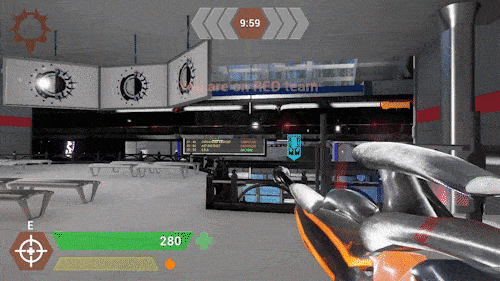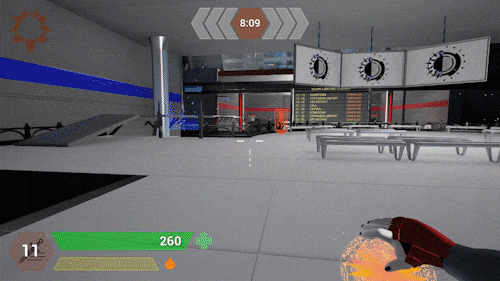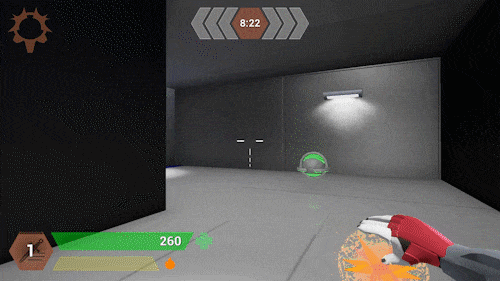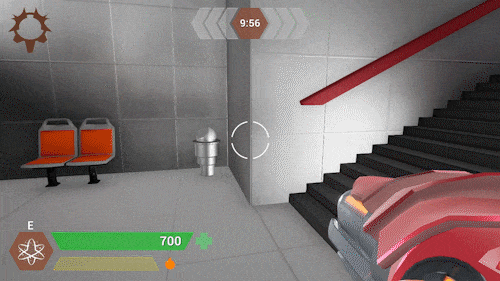

DEVELOPMENT INFO
RESPONSIBILITIES
GAME: Auxilium
MAP: Railways
GENRE: First-Person Action RPG
TOOL: Unreal Engine 4
TEAM SIZE: 49 (Students)
DEV TIME: 4 months
Lead Level Designer
-
Initial concept of map (Railways)
-
Creation of map LDD
-
Team leadership (map team of 4)
-
Unreal Blueprint visual scripting
-
Level modkit implementation
-
Global sound design and implementation
-
Interdisciplinary communication
-
Map balance, pacing, and flow
Download Auxilium Installer
MAP SUMMARY
"Railways" is a 2-Flag Capture the Flag map created for the multiplayer First Person Shooter Auxilium in Unreal Engine 4. The map takes place inside the main platform of the recently vacated Central Station, and features:
-
Trains that periodically cross through the platform, creating potential hazards that players must navigate around
-
Jump pads that can send players over the platform and between trains
-
Underground hallway with moving walkways
-
Multiple entry points into flag bases
-
A suspended catwalk on one side of mid (right side for Red, left side for Blue)

Top-Down Overview of Railways
 |  |  |
|---|---|---|
 |  |  |
 |  |  |
Screenshot Gallery
MY ROLE AND RESPONSIBILITIES
As a Lead Level Designer, my job was to lead a team of level designers in developing a fully functional CTF map while staying true to the project's core attributes and coordinate with the rest of the team regarding resources, art and programming assets. I led whiteboard sessions for the initial development of the map layout, and worked with the team to block out the layout and adjust based on feedback. When tough technical problems arose, I led the effort to diagnose and deal with the issues as quickly and efficiently as possible.
Hover to see screenshot of finalized map
In addition to my general leadership responsibilities, I also took charge of the overall design development of the map from start to finish, making sure the map can be enjoyed by many different types of players. Our map proved to be immensely popular during playtests, with players coming back to play it time and again.
Adjusting for Game Mode
Originally, Auxilium planned to have maps either have 2-Flag CTF or Deliver the Bomb game modes. However, the entire team was forced to cut the Deliver the Bomb mode midway through development due to time constraints.
In the case of "Railways", we designed our map to be able to accommodate both game modes, generating positive playtest reactions to both modes. When one mode was cut, we adjusted accordingly by streamlining the cover around the lower platforms to emphasize north-south movement rather than as a point of contention.
Adjusting Map Size to Fix Pacing
"Railways" went through a lot of changes in regards to size and pacing. Originally, the map was designed to be a lot bigger, with two extra flag rooms extending beyond the current map and a side underground path across from the catwalk in mid area. However, when the character classes started to take shape, we discovered that it took way too long for players to move from one end of the map to the other.
To fix the pacing issue, we decided to:
-
Cut both flag rooms and move the flag spawns to the outer rooms
-
Cut 1 row of tiles from both upper lobbies to shorten distance from flag room to central platform
-
Add an underground entrance beneath the upper lobbies with moving catwalks that take players to flag rooms faster via a third entry point (Jump Pad Room)
We originally included a side underground path to give players the option of avoiding the moving trains in the central platform. However, during playtesting we noticed that players did not like taking this path because it took too long and removed players from the action. So we decided to cut this path entirely and add four jump pads along the edges of the platform.

Diagram of map changes
GAMEPLAY FLOW
We set out to design the map to fit many different playstyles. With the game being a class-based shooter, we focused on designing for the four base classes in the game: Sniper, Infiltrator, Juggernaut, and Assault.
In addition, we designed the map to be "easy in, hard out", where players can get to the flag quickly but must utilize skill and teamwork to carry the flag out of the enemy base.
Sniper Sightlines
The Sniper is the standard long-range unit primarily used to control sightlines and provide massive burst damage potential that can quickly turn the tide of the fight. We wanted the Sniper to be a powerful and dynamic pick on this map, so we made sure to create clear and definitive angles for players to take. However, we also did not want the Sniper to overpower the other classes, so we added obstructions such as the schedule board, platform doors, and video kiosks to create cover for advancing and retreating players.


Example sniper gameplay on upper lobby and catwalk
Mobility
The Infiltrator is the fastest character class in Auxilium at the cost of having lower base health than the other classes (Snipers can kill them with one shot). The play style of the Infiltrator emphasizes mobility, and players can periodically use a Dash ability to get a short speed boost and outrun other characters. Early in development, we discovered that the Infiltrator's Dash ability can be combined with their jump and movement momentum to send the Infiltrator zipping across the map really quickly, a quirk the design team labeled the "Kippy Skip".
We worked this character's mobility into our map design by keeping the upper portion of the mid room open so Infiltrators can launch themselves from the upper lobby and land close to the central train platform. This opened up a lot of possibilities for good-feeling movement, generating overwhelmingly positive responses during playtesting and creating new strategies during gameplay.

Using "Kippy Skip" to reach opposing base quickly
Flag Room Flow
The flag rooms play host to critical conflict scenarios between attackers and defenders, so we spent a lot of time getting the flow of the flag room to feel right.
We wanted attackers to be able to get in and out of the base smoothly. At the same time, we wanted to make sure defenders could hold from a strong position but not have complete control of the room at any given time. With this in mind, we decided upon a three-entrance layout and positioned the three entrances so that defenders cannot reliably cover all three at the same time, but still have a strong enough presence to make a contested defense.

Diagram of paths and flow in flag room
As noted in the image above, the layout of the flag room makes it so that defenders can only reliably cover two entrances at any given time, giving them a decent chance of intercepting attacking players but not a 100% sure bet going into the fight.
Defending angles in Flag Room
On the attacking side, one common strategy that developed through playtests involved the Infiltrator player performing a really quick flag-take by entering from one entrance, dashing over the flag, and exiting really quickly through another entrance.

Example of flag capture flow



